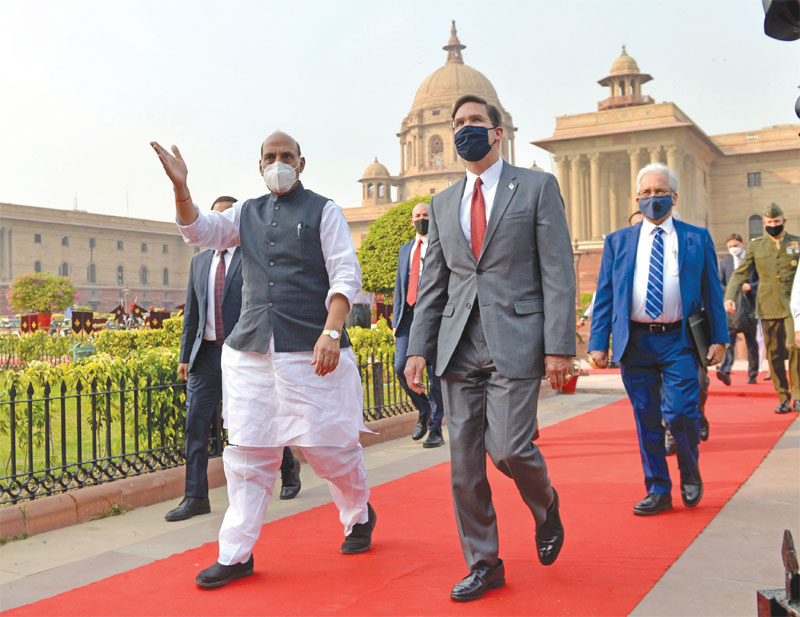The cost of signing BECA will be huge and not in India’s long term interest
 Pravin Sawhney
Pravin Sawhney
With the signing of Basic Exchange and Cooperation Agreement (BECA), India has potentially mortgaged digitized military capability of its three services--army, air force and navy--to the United States. If this sounds startling, it is.
Working in tandem with the Communication, Compatibility and Security Agreement (COMCASA) signed in 2018, the two are much more than about developing inter-operability (ability to fight together against common enemy) as said in media reports and background briefings. If that was not bad enough, through the twin-routes of datasets (given under BECA) and the systems (given under COMCASA), Indian indigenous kill-chains (sensors to shooter networks working through command center) would potentially be under US’ control through its humongous cyber capabilities.
What prompted the Modi government to take this mindlessly suicidal extreme step, considering India is neither US’ military ally nor has any commitment that US military would fight its wars, has been indicated by an Indian-American analyst. On eve of the BECA signing, senior fellow at US’ Brookings Institute, Tanvi Madan tweeted, ‘Arguably without Doklam and Ladakh crisis, India would not have got to yes on COMCASA or reportedly BECA.’ The reality is India has cut off its nose to spite the Chinese by (a) flaunting untested strategic ties with the US, and (b) in the hope that US’ geospatial intelligence and real-time images datasets would help accuracy of India’s long range firepower comprising its cruise missiles, multi barrel rocket systems and probably the Russian S-400 air defense missile system once its joins the inventory.
By signing the India-specific COMCASA, India was given highly encrypted classified security equipment, and by signing BECA, the US would share its military Geographic Information System (GIS) comprising topography, terrain and weather information for mission planning. It would also get US’ satellite imagery (data and video), GPS military resolutions and datasets from its airborne assets. The huge volume of US datasets from diverse sensors would come to Indian command centres through the special COMCASA equipment. Since good quality and real-time datasets is the new ammunition of the digitized warfare, it could be shifted quickly (perhaps with US-assisted Artificial Intelligence means) and given to both the armed drones being procured from the US and well as weapon platforms with the three services for precise stand-off firepower.
At the face of it, this would be great. But deep down, India has opened the space for US to exercise widespread cyber mala fide activities, should it so decide. Malicious cyber activities do not happen only through cyberspace, but through systems too. These include computer software, embedded processors, routers, all wired and wireless transmission, controllers and so on. While systems are accessed through cyberspace, there are other paths that cyber nerds can use to introduce egregious errors into computer systems without using the internet. For instance, the US’ COMCASA equipment could have embedded cyber logic bombs; these are nano malware (malicious software) codes that start functioning when certain conditions are met, or outside instructions are given after months or even years. They could then start deleting datasets files or corrupt them inducing malfunctions in the kill-chain leading to missiles going awry if not running amok. To be sure, the best of the ballistic, cruise or hypersonic missiles in the world depend on the robustness of the kill-chain supporting it. This explains why major power like US, China and Russia pay special attention to having cyber and electronic hardened kill-chains.
Since the US (cyber) experts would be authorized COMCASA system users, they could corrupt datasets on command for as long as they want. Or there could be dataset poisoning; it could be falsified or corrupted. The US could even overwrite Indian short-range, point to point radio frequency connections by long-range high-powered signals from beyond physical parameters. Moreover, the US has developed impressive nano weapons capable of transiting through cyberspace to disrupt or destroy physical infrastructure. Case is point is world’s first known cyberweapon with nanotechnology called Stuxnet computer worm of 2010--US was suspected to be behind it--that could link the cyber domain with the physical domain. The US has numerous cyber weapons and techniques capabilities including installing information mines; information reconnaissance; changing network data; dumping information garbage; disseminating propaganda; applying information deception; releasing clone information; establishing network spy stations and so on.

It is no one case that the US would carry out malfeasant cyber activities against its strategic ally, India. However, the important issue is capabilities and not intentions. By signing of the COMCASA and BECA, India has permitted the US entry into its military’s growing digitized space, something no nation other than military ally—all with excellent indigenous cyber capabilities--would do.
You must be logged in to view this content.

